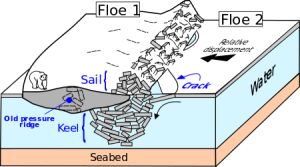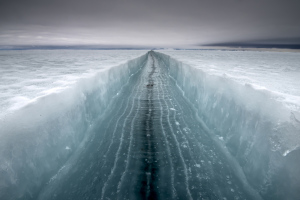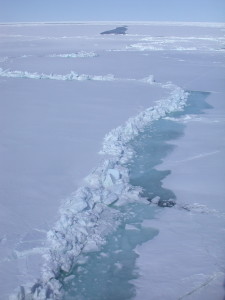Addbeginum
The following is a graph of the density of ice:

When I first wrote the article, I said that ice expands when heated. Then I realised that ice expands when it forms, so I then reworked the article to change the time of expansion to the night and not day. Finally, I realised that actually I’d got it right first time and that the bulk ice, as it cools, it gets more dense and contracts.
In a discussion with TinyCO2 I referred to the formation of pressure ridges and refrozen cracks which form as a result of the daily change in air temperature over the ice.
This is a direct analogy to the creation of subduction zones and mid-oceanic ridges in the Caterpillar theory. So, this is quick article to put together the information on the effect of daily (or for thicker ice perhaps longer) temperature changes on ice.
First let’s see a pressure ridge:
The main feature is that it is a jumble of ice running along a line in the middle of an otherwise flat piece of ice. And here is a simple diagram of one in cross section:
 All you really need to know, is that the ice of either side is subject to huge pressure bringing them together. This can occur due to the pressure of wind in places like the Arctic ocean. But in large lakes the pressure results from the expansion of the ice which pressing on the shores has no where to go until eventually the ice fractures along a line causing some ice to be pushed down, and some up. The ice pushed down, adds to the buoyancy, until the join is pushed upwards, whereupon when the ice is next pushed together it is pushed up. That is until the weight pushed the join down. The result is a chaotic mess of ice (which is not the same as a rock subduction zone – where the rock is less buoyant and tends to melt).
All you really need to know, is that the ice of either side is subject to huge pressure bringing them together. This can occur due to the pressure of wind in places like the Arctic ocean. But in large lakes the pressure results from the expansion of the ice which pressing on the shores has no where to go until eventually the ice fractures along a line causing some ice to be pushed down, and some up. The ice pushed down, adds to the buoyancy, until the join is pushed upwards, whereupon when the ice is next pushed together it is pushed up. That is until the weight pushed the join down. The result is a chaotic mess of ice (which is not the same as a rock subduction zone – where the rock is less buoyant and tends to melt).However, whilst the ice expands during the day (ice expands when warmed – at least until it melts), and tends to increase the size of the pressure ridge, at night it cools and contracts and exposes water that then freezes. As such cracks tend to open up as shown below.
 The example shown above shows multiple ridges. These are probably from a daily temperature cycle, but it appears that the ice is generally contracting away from this crack. That may be due to a period of cooler weather. This probably illustrates the early phase of a pressure ridge. The thick ice contracts leaving open water that then freezes. But when the weather turns warmer, the ice expands, the crack closes, and because the ice in the crack is relatively thin, this is where it gives way.
The example shown above shows multiple ridges. These are probably from a daily temperature cycle, but it appears that the ice is generally contracting away from this crack. That may be due to a period of cooler weather. This probably illustrates the early phase of a pressure ridge. The thick ice contracts leaving open water that then freezes. But when the weather turns warmer, the ice expands, the crack closes, and because the ice in the crack is relatively thin, this is where it gives way.Repeated hot and cold weather would leave a jumble of ice at this spot. Eventually, there would be such a tangle, that when the ice contracts, it will tend to force open another crack. At this point there can be two types of crack: one where ice tends to come together in warm weather and form a ridge, and others where it tends to contract in cold weather forming open water which then freezes. If this happens it more or less matches the Caterpillar effect:
Caterpillar Theory
 Just a quick recap. The Caterpillar Effect is when over the much longer ice-age cycle the crust heats up and cools. During cooling, it contracts pulling apart at mid-oceanic ridges. However unlike the ice, magma is pushed up – like the ice it freezes. When the world then warms, the rock pushes against each other at subduction zones. Here one layer is pushed down under the other. But unlike ice, it melts (so does not create a jumble of rocks) giving rise to a line of volcanoes about 100km from the subduction trench. The other effect which is common to ice and crust, is that the movement is in a series of “creaks” – which in the crust are known as earthquakes.
Just a quick recap. The Caterpillar Effect is when over the much longer ice-age cycle the crust heats up and cools. During cooling, it contracts pulling apart at mid-oceanic ridges. However unlike the ice, magma is pushed up – like the ice it freezes. When the world then warms, the rock pushes against each other at subduction zones. Here one layer is pushed down under the other. But unlike ice, it melts (so does not create a jumble of rocks) giving rise to a line of volcanoes about 100km from the subduction trench. The other effect which is common to ice and crust, is that the movement is in a series of “creaks” – which in the crust are known as earthquakes.
But the general principle is the same. The pressure ridges form, because each night the ice creeps forward and each day (if cold enough) the gaps freeze. Likewise each ice-age cycle the rock pushes forward and then the mid-oceanic rock fills in the gap when it contracts.
For more see: The Caterpillar Effect: Now with second confirmation it must be rock solid science
Videos and other info
And here is a PhD: Growth, Structure, and Desalination of Refreezing Cracks in Sea Ice
Here is a video, in which you can hear the “icequakes” as the ice pushes against itself. There is a very regular creaking plus an occasional large “boom”. These correspond to what happens to the much thicker earth over an inter-glacial:
This one shows a crack which is just restarting to freeze
And this shows a number of cracks in various stages:
I couldn’t find any decent videos of pressure ridges on lake ice which would have been nice, but eventually I found this one on sea ice.



Agreed that it is the average temperature of the surface air at any particular latitude that determines the temperature (limits the cooling) of the crust at what ever depth it stabilises from seasonal and diurnal variation.
However the average temperature at the ocean floor would never vary from just above freezing unless solid ice.
So I propose another mechanism for triggering volcanic activity beneath the seas.
That a drop in water pressure at the ocean floor due to the lowering of sea levels by 400ft in ice ages would enough to uncork the bottle of champagne so to speak.
Vice versa during interglacials to suppress activity hence the rhythmic nature of mid ocean ridge expansion.
Thanks, you are quite right, and unfortunately not much of the ocean current lies above the Thermocline. However, the earth’s surface still expands and contracts with temperature, so this means we have differential movement – which in itself ought to lead to predictable effects.
One ought to be a tendency to have subduction and mid-oceanic ridges parallel to continental shelves. The other is we ought to get slip faults at the end of long straight continental shelves (the land will expand and contract, but the sea floor will not).
On the water depth – like a water bed filled with treacle, if you took a weight off it, the treacle would then slowly move SIDEWARDS to bring the surface back up to an equilibrium. There would be earthquakes, but you are bending the crust rather than thrusting it outwards
Ok, I’ve been looking at plates movement maps. In general, if you follow one of the arrows – one side of the movement points to land – but there’s a lot of land and even a random arrow might have that property.
The odd one is the San Andreas fault.
However, the more I look at this, the more I’m thinking: “this explains why almost all the faults run between continents” … as such this may explain why all the continents appear to fit neatly together.
The outward movement starts with a hot spot as I understand it. That’s where crust is being created. That can be anywhere, but over time it tends to end up in the ocean because the land (if it starts on land) parts company and water fills the gap. The hotspot may create land (eg iceland) and volcanoes but as the crust is moving away from the source of creation, there may never be enough rock to break the surface.
At the other end of the flow the first thing that happens is the bits crunch up, forming mountains. Then one plate slides under the other and the friction creates volcanoes. Land is thus a mixture of volcanic rock and pushed up sea floor.
What causes the hotspots is still unknown as far as I know and they don’t all create new plate divides eg Hawaii is supposed to sit over one but the sea bed moves over it rather than parts. Also Yellowstone is also over one but creates super volcanoes instead of a split. Scotland and the Lake district have extinct super volcanoes, a reminder of the early start of the North Atlantic split.
Addition – water is supposed to play a part in subduction so new subduction zones may have to start at a coastal region.
Thanks for the comments. After Pablo’s comment, I’ve realised the situation is a lot more complex than I was originally proposing. And after thinking about that and your own comments it’s got a lot bigger.
So, I’ve been looking at it and trying to work out what is going on. So far it’s looking promising – but because it’s more complex there’s a lot more to consider. So, I’m going to hold fire on further comments for a while.